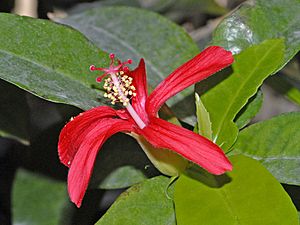Hibiscus clayi facts for kids
Quick facts for kids Hibiscus clayi |
|
|---|---|
 |
|
| At the Jardin des Plantes, Paris | |
| Conservation status | |
| Scientific classification | |
| Synonyms | |
|
The Hibiscus clayi, also known as the red Kauai rosemallow or Kokiʻo ʻula (its Hawaiian name), is a beautiful flowering plant. It's a type of hibiscus that grows in Hawaii. This special plant belongs to the mallow family, which includes many other well-known plants.
What's in a Name?
The first part of the plant's name, Hibiscus, comes from an old Greek word, hibískos. This was the name a Greek doctor, Pedanius Dioscorides, gave to a similar plant long ago. The second part of its name, clayi, honors Horace F. Clay. He was a person who studied and grew plants in Hawaii.
What Does it Look Like?
The Hibiscus clayi can be a small bush, about 40 to 90 centimeters (about 1.5 to 3 feet) tall. It can also grow into a tree, reaching heights of 4 to 8 meters (about 13 to 26 feet). Its leaves are a medium green color and look shiny. They can have smooth edges or be slightly toothed at the tip.
This plant produces single, showy flowers at the ends of its branches. These flowers are usually bright or dark red. You can see them blooming all year round! They look quite similar to another Hawaiian hibiscus called Hibiscus kokio. Sadly, the United States Fish and Wildlife Service (USFWS) lists this plant as endangered.
Where Does it Grow?
This special plant is found only in Hawaii. It grows naturally in the dry forests of the Nounou Mountains. These mountains are located in eastern Kauaʻi, one of Hawaii's islands. You can find it at elevations from 50 to 600 meters (about 164 to 1,968 feet) above sea level.
Because it's found in so few places, the Hibiscus clayi is listed as Critically Endangered on the IUCN Red List. This means it is at a very high risk of disappearing forever.
See also
 In Spanish: Hibiscus clayi para niños
In Spanish: Hibiscus clayi para niños


